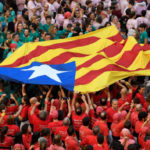
(LONDON) — When an independence referendum was held in Catalonia on Oct. 1, 2017, some citizens in Spain saw an illegal travesty — and others viewed the vote as a sign of hope.
Elisenda Paluzie, a University of Barcelona economics professor, who favors independence, said she endured an all-night plight to vote in the referendum after Spanish police confiscated ballot boxes at her voting center.
The Parliament of Catalonia passed the referendum, but the Constitutional Court of Spain declared the vote unconstitutional. About 90% voted in favor of separating from Spain. The Spanish government placed doubt on the quality of these landslide results, alleging voters could cast multiple ballots.
In the five years since the referendum, tensions within the wealthy, autonomous region of Spain have remained high, while the concerted effort to separate has waned, according to the Center for Opinion Studies.
Despite the pandemic and war in Ukraine threatening Europe’s economy, the question of the region’s autonomy continues to polarize Catalonia, as recorded by the Library of Congress. Still, pro-independent activists and anti-separatists agree on one idea: the route to independence is uncertain.
In the coming months and years, further developments could propel or quell the movement, including the Spanish elections on May 28, 2023, and Catalan regional elections in 2025, Paluzie said. Experts on both sides of the issue predict a right-wing win in upcoming elections would mobilize the movement, said Paluzie and anti-separation politician Rafael Arenas. Both sides doubt a future with compromise in it, they added.
United Nations research published in the past six months said that at least 65 separatist leaders have been surveilled by spyware made by Israel’s NSO Group. The spyware investigation lacks proof of Spanish federal involvement, said Arenas.
One alleged target, Paluzie, also works as the vice president of the Unrepresented Nations and Peoples Organization in Washington. Since the referendum, she said the independence effort has mostly “retreated under repression.”
“Now we are in a turning point of starting to retake positions,” Paluzie said.
David Aguinaga, a city council member in Terrassa, east of Barcelona, said Catalonia is still “at a stalemate.” Aguinaga said he opposes the movement because he believes in the Spanish constitution. He said he didn’t vote in the referendum.
“This isn’t a conflict between Spain and Catalonia,” Aguinaga said. “This is a civil conflict in Catalonia, among those who are for independence, and those who are against independence.”
From 2015 to 2016, Arenas, the former president of Societat Civil Catalana, utilized the courts to remove public funding and enact bans against local governments using public buildings to display Catalonian flags, which he said were “using public funds for partisan propaganda.” Societat Civil Catalana is an organization countering the independence movement.
On Aug. 31, the U.N. Human Rights Committee said Spain violated international human rights by suspending four Catalan independence leaders from their positions.
Erika Casajoana, deputy representative of the Catalan Government to the EU, said the negotiations on the global stage have been hard-fought, like the debates at home.
“Victories before international institutions justify us, but will not get us to independence, we need to make independence ourselves,” Casajoana said.
An obstacle to those seeking independence is their lack of singular leadership, Casajoana said. The two biggest pro-independence parties in the Catalan government — Esquerra Republicana (the Catalan Republican Left) and Junts (Together for Catalonia party) — are evenly matched in the Catalan parliament, splintering the movement’s efforts.
“There’s no way back,” Casajoana said. “We only can break away. The moment Spain lifts the boot, boom, we are gone.”
Copyright © 2022, ABC Audio. All rights reserved.
